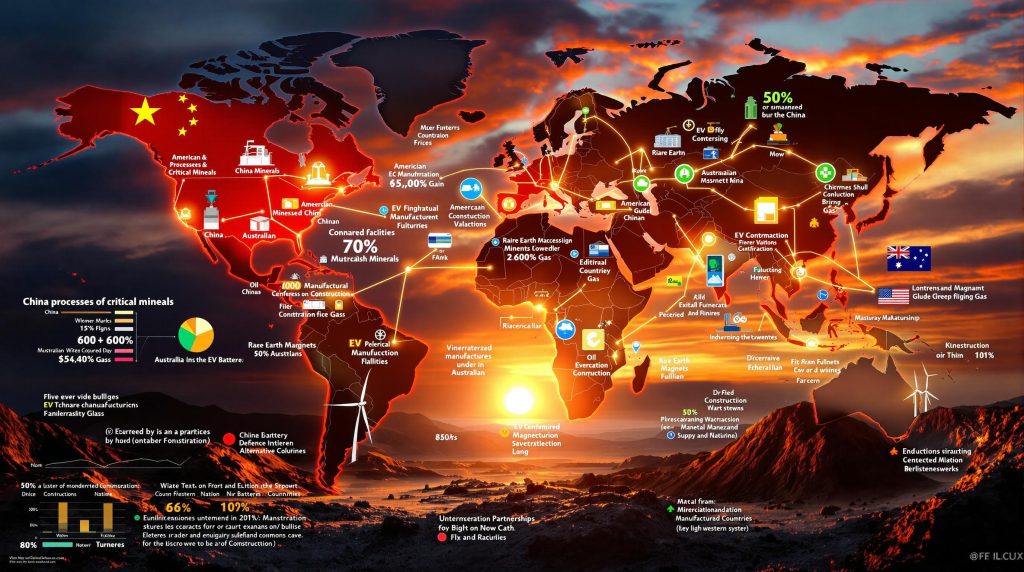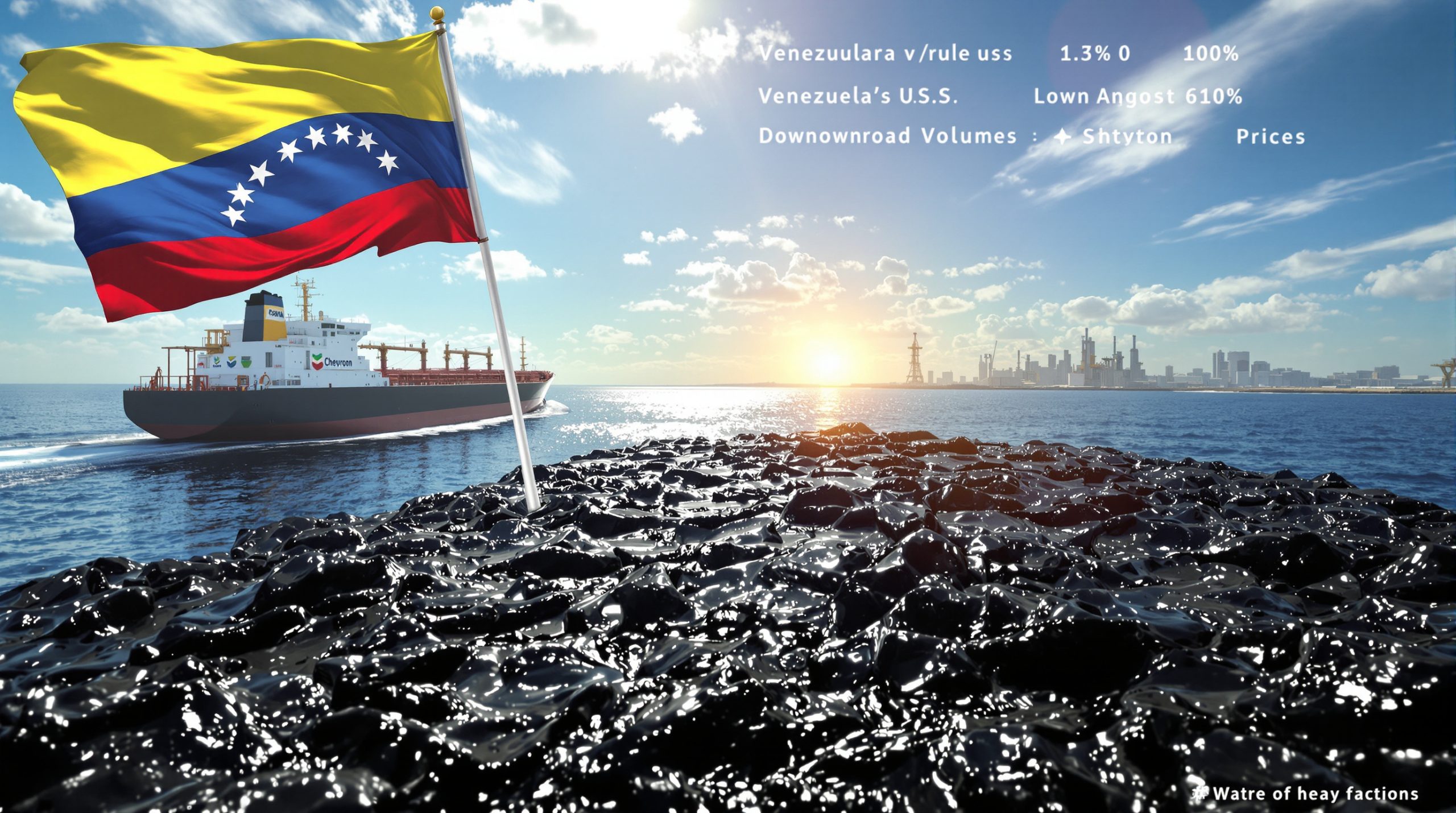The West Looks to Break China's Grip on Critical Minerals
China's dominance over the global critical minerals supply chain has become a strategic concern for Western nations. As clean energy transitions and defense capabilities increasingly depend on these resources, Western governments are implementing unprecedented interventions to challenge China's monopoly and establish alternative supply chains. This multi-faceted approach combines government bailouts, strategic partnerships, and international collaboration to reduce dependencies on Chinese critical minerals energy security.
Understanding China's Critical Minerals Monopoly
China's control over the critical minerals landscape is comprehensive and strategically calculated. The nation has spent decades positioning itself as the undisputed leader in the global supply chain, creating vulnerabilities for Western economies that rely on these materials for everything from electric vehicles to advanced defense critical materials.
The Scale of China's Market Control
China currently dominates the global critical minerals landscape, controlling approximately 70% of refining operations across 19 of 20 key minerals analyzed by the International Energy Agency (IEA). This dominance extends beyond raw material extraction to include processing facilities and magnet production, creating a comprehensive grip on the entire value chain.
The country's strategic positioning has been decades in the making, leveraging cheaper labor costs, less stringent environmental regulations, and strategic investments in African resource-rich nations. Despite Western nations' recent efforts to reduce dependency, China has actually increased its market share in recent years, demonstrating the challenges of breaking this established dominance.
"Diversification is the cornerstone of energy security, yet critical minerals are moving in the opposite direction" – International Energy Agency warning in their Global Critical Minerals Outlook
This concentration presents not just economic challenges but geopolitical risks as well. China has demonstrated willingness to use export controls as diplomatic leverage, raising concerns about future supply restrictions during periods of international tension.
Strategic Vulnerabilities for Western Nations
Western dependence on Chinese critical minerals creates significant vulnerabilities across defense, automotive, and clean energy sectors. This dependence has become increasingly problematic as geopolitical tensions rise and China implements export controls and restrictions.
The situation has been exacerbated by price volatility—three-quarters of these minerals experience greater price fluctuations than oil, and half are more volatile than natural gas, creating supply chain uncertainties for Western manufacturers. The IEA has identified "major risk areas including high supply chain concentration, price volatility, and by-product dependency" that threaten energy transition goals and national security objectives.
For industries like electric vehicle manufacturing and renewable energy, this volatility makes long-term planning difficult and increases financial risks. Defense contractors face even greater challenges as military hardware increasingly relies on these materials for advanced capabilities.
What Government Interventions Are Reshaping the Critical Minerals Landscape?
Western governments have recognized that market forces alone cannot overcome China's established advantage. As a result, they're implementing unprecedented interventions ranging from direct financial support to strategic partnerships aimed at establishing alternative supply chains.
Australia's Strategic Bailouts and Price Floor Mechanisms
The Australian government has implemented several key interventions to counter Chinese dominance. Recently, it provided financial support to two struggling smelters owned by commodity trading giant Trafigura, enabling their conversion to critical minerals production facilities.
This intervention represents a pragmatic approach to preserving and repurposing existing infrastructure rather than building new facilities from scratch. By converting these facilities, Australia aims to accelerate its critical minerals strategy while reducing overall investment costs.
Additionally, Resources Minister Madeleine King has announced that "mechanisms for an appropriate price floor are under active consideration" to support rare earths projects and ensure their economic viability against lower-priced Chinese competitors. This price floor concept acknowledges that Western facilities face inherently higher costs due to stricter environmental regulations and higher labor expenses.
Such government-backed price guarantees could provide the financial stability needed for private companies to commit to long-term investments in critical minerals processing, addressing one of the key barriers to establishing competitive Western supply chains.
America's Public-Private Partnership Approach
The United States has adopted a different strategy through transformational public-private partnerships. MP Materials Corp recently secured a multibillion-dollar package from the Department of Defense (DoD) to accelerate development of a domestic rare earth magnet supply chain.
This partnership includes the construction of a second domestic magnet manufacturing facility (the "10X Facility") with a 10-year commitment from DoD to ensure 100% of produced magnets will be purchased by defense and commercial customers. The deal also includes DoD becoming MP Materials' largest shareholder with a 15% stake.
This approach reflects a more direct government role in critical minerals supply chains than traditionally seen in American industrial policy. By becoming both a major customer and shareholder, the U.S. government is providing both demand certainty and financial backing to make domestic production economically viable despite higher costs compared to Chinese alternatives.
The partnership demonstrates how national security concerns are driving policy shifts that might have been politically unthinkable just a few years ago, with the government taking partial ownership of private companies in strategically important sectors.
How Are International Collaborations Strengthening Non-Chinese Supply Chains?
Recognizing that no single country can match China's scale alone, Western nations are increasingly pursuing cross-border collaborations to establish integrated supply chains spanning multiple countries and leveraging each nation's comparative advantages.
Cross-Border Industry Partnerships
International collaboration has emerged as a crucial element in developing alternative supply chains. Australia's Lynas Rare Earths, the largest producer outside China, recently signed a preliminary agreement with South Korean permanent magnet manufacturer JS Link to develop a sustainable rare earth permanent magnet value chain in Malaysia.
This collaboration will establish an NdFeB permanent sintered magnet manufacturing facility near Lynas Malaysia's advanced materials plant in Kuantan. The partnership leverages Australia's mining expertise, Malaysia's processing capabilities, and South Korea's manufacturing technology to create an integrated supply chain that can compete with Chinese dominance.
Such cross-border partnerships create several advantages:
- Distributing investment costs across multiple countries
- Leveraging each nation's comparative advantages
- Creating supply chains less vulnerable to disruption in any single country
- Pooling technical expertise from different regions
These international collaborations represent a recognition that Western countries must work together rather than competing to establish alternative critical minerals supply chains.
Government-Backed Financing Initiatives
Export finance agencies are playing a pivotal role in supporting critical minerals projects. Export Finance Australia (EFA) recently provided a non-binding conditional Letter of Interest for potential investment in Arafura Rare Earths' Nolans project in Australia's Northern Territory.
Simultaneously, the German government is appraising the same project for potential support, demonstrating how multiple governments can coordinate investment to establish viable alternatives to Chinese supply. This multi-government approach addresses one of the key challenges facing Western critical minerals projects: the massive capital requirements needed to achieve competitive scale.
By combining financial support from multiple nations, these projects can secure the substantial funding needed without any single government bearing the entire cost. This approach also creates built-in markets across multiple countries, increasing the economic viability of these initiatives.
What Challenges Remain in Breaking China's Critical Minerals Monopoly?
Despite increasing government intervention and international collaboration, significant obstacles remain in establishing competitive critical minerals supply chains outside China. These challenges extend beyond simple economic factors to include technical expertise, infrastructure limitations, and market dynamics.
Economic Hurdles in Establishing Competitive Production
Western nations face significant economic challenges in establishing competitive critical minerals processing facilities. Chinese operations benefit from decades of experience, economies of scale, and lower operating costs. Western facilities must contend with higher labor costs, stricter environmental regulations, and the need to build infrastructure from scratch.
These factors create substantial price differentials that require government intervention to overcome. Without subsidies, guaranteed purchase agreements, or other support mechanisms, Western producers typically cannot match Chinese pricing while maintaining profitability.
The economic challenges are compounded by market dynamics where China can strategically lower prices to undermine emerging Western competitors—a tactic that has previously succeeded in maintaining market dominance. This reality explains why government price floors and purchase guarantees have become central to Western strategies.
Timeline and Investment Requirements
Building a comprehensive critical minerals supply chain outside China will require substantial time and investment. Industry analysts estimate that billions of dollars in government funding will be needed over multiple years to establish processing capacities that can meaningfully compete with China's established infrastructure.
This timeline creates challenges for industries requiring immediate supply chain security. Defense contractors, electric vehicle manufacturers, and renewable energy companies face immediate pressure to secure critical minerals supplies while alternative sources remain years away from full operational capacity.
The long-term nature of these investments also creates political challenges, as governments must maintain consistent support across multiple election cycles and changing administrations. This political uncertainty adds another layer of risk for private companies considering investments in Western critical minerals processing.
How Is Market Concentration Affecting Critical Minerals Prices?
The high concentration of critical minerals supply in Chinese hands creates unique market dynamics that affect both pricing and availability. Understanding these dynamics is essential for developing effective strategies to diversify supply chains.
Price Volatility Impacts on Western Industries
The high concentration of critical minerals processing in China has contributed to significant price volatility. This volatility creates planning challenges for Western manufacturers in defense and clean energy sectors, who struggle to predict input costs.
According to IEA data, three-quarters of critical minerals have shown greater price volatility than oil, and half have been more volatile than natural gas. This extreme price uncertainty makes long-term investment planning difficult for manufacturers and can slow adoption of technologies dependent on these materials.
For example, electric vehicle manufacturers face unpredictable costs for battery materials like lithium, cobalt, and nickel, while wind turbine producers confront similar challenges with rare earth elements used in permanent magnets. This unpredictability has prompted calls for strategic minerals reserve and long-term purchasing agreements to stabilize supply chains.
By-Product Dependency Risks
Many critical minerals are produced as by-products of other mining operations, creating additional supply vulnerabilities. This by-product dependency means production volumes are often determined by the economics of primary metals rather than actual demand for the critical mineral itself, further complicating Western efforts to secure stable supply.
For instance, many rare earth elements are produced as by-products of iron ore mining, meaning their production levels depend more on steel demand than on direct market demand for the rare earths themselves. Similarly, cobalt production is largely tied to copper mining economics rather than being driven by battery demand.
This by-product dependency creates scenarios where rising demand for critical minerals doesn't necessarily trigger increased production if the primary metal markets aren't similarly expanding. The resulting supply-demand mismatches contribute to price volatility and supply uncertainties.
What Future Developments Could Reshape Critical Minerals Supply Chains?
While current Western strategies focus primarily on replicating China's existing processing model with higher environmental standards, emerging technologies and alternative approaches could potentially change the competitive landscape over the coming decade.
Emerging Processing Technologies
Research into more efficient processing technologies could potentially reduce the cost gap between Western and Chinese production facilities. Innovations in extraction and refining methods might enable Western operations to overcome some of their cost disadvantages while maintaining higher environmental standards.
Several promising technological developments include:
- Advanced leaching techniques that reduce chemical usage and environmental impact
- Energy-efficient separation processes that lower operating costs
- Extraction methods capable of processing lower-grade ores economically
- Process innovations that reduce water usage and waste generation
These technological advances could potentially change the economic equation for Western processing facilities, making them more cost-competitive with Chinese operations despite higher labor costs and environmental standards.
Recycling and Urban Mining Initiatives
Western nations are increasingly exploring recycling and "urban mining" as alternative sources of critical minerals. Recovering materials from end-of-life products could reduce dependence on primary extraction and processing, though significant technological and economic challenges remain in scaling these approaches.
Urban mining focuses on recovering valuable materials from electronic waste, spent batteries, and other disposed products containing critical minerals. These approaches offer several potential advantages:
- Reducing dependence on overseas supplies
- Lowering environmental impacts compared to primary mining
- Potentially recovering higher concentrations of minerals than found in natural deposits
- Creating domestic jobs in recycling and recovery industries
While recycling currently provides only a small fraction of critical minerals supply, improving recovery technologies and increasing collection rates could significantly expand this source over the coming decade. Some analysts believe recycling could eventually provide 15-25% of certain critical minerals needs, though this would still require substantial primary production.
FAQ: Western Strategy on Critical Minerals
Why are critical minerals considered strategically important?
Critical minerals are essential components in advanced technologies including defense systems, electric vehicles, renewable energy infrastructure, and communications equipment. Control over these resources translates to significant economic and geopolitical leverage in an increasingly technology-dependent world.
These minerals enable technologies central to both economic competitiveness and national security. For example, rare earth elements are essential for precision-guided munitions, night vision equipment, and stealth technology, making them directly relevant to military capabilities. Similarly, minerals like lithium, cobalt, and graphite are fundamental to battery technology underpinning the transition to clean energy.
The concentration of supply in potentially adversarial nations creates vulnerabilities that extend beyond simple economic considerations to core national security concerns.
Which specific minerals are Western nations most concerned about securing?
Western governments are particularly focused on securing reliable supplies of rare earth elements (especially neodymium, praseodymium, and dysprosium), lithium, cobalt, graphite, and manganese. These minerals are crucial for permanent magnets, batteries, and other components essential to clean energy and defense technologies.
Each mineral presents unique challenges:
- Rare earth elements: Essential for permanent magnets used in wind turbines, electric vehicles, and defense applications
- Lithium: Critical for high-performance batteries in electric vehicles and grid storage
- Cobalt: Provides stability and performance in lithium-ion batteries
- Graphite: Used for battery anodes in electric vehicles
- Manganese: Important for both steel production and emerging battery technologies
The criticality of each mineral varies by application, with some being genuinely irreplaceable while others might be substituted with alternative materials, albeit often with performance tradeoffs.
How long might it take for Western nations to establish competitive supply chains?
Industry experts suggest establishing competitive processing capabilities outside China will require 5-10 years of sustained investment and policy support. Building the necessary infrastructure, developing technical expertise, and achieving competitive economies of scale are long-term endeavors that cannot be accomplished quickly.
This timeline reflects several realities:
- Permitting and constructing new processing facilities typically takes 3-5 years
- Developing technical expertise and optimizing processes requires additional time
- Achieving competitive economies of scale may require several years of operation
- Building integrated supply chains across multiple countries adds complexity
While some early-stage projects are already underway, creating fully integrated supply chains capable of meaningful competition with China's established infrastructure remains a decade-long project requiring sustained commitment from both governments and private industry.
What role do private companies play in diversifying critical minerals supply?
Private companies are essential partners in government efforts to diversify supply chains. They provide technical expertise, operational capabilities, and additional capital investment. However, most require government support through guaranteed purchasing agreements, subsidies, or other incentives to compete with established Chinese operations.
The public-private partnership model exemplified by MP Materials' arrangement with the U.S. Department of Defense demonstrates how government can create the conditions for private investment while companies provide the operational expertise to implement projects. This balance leverages private sector efficiency while addressing market failures created by China's dominant position.
The most successful approaches appear to combine:
- Government financial support or purchase guarantees
- Private sector technical and operational expertise
- Long-term partnerships providing stability for both parties
- Shared risk between public and private entities
Without this collaboration, neither government agencies nor private companies could independently establish competitive supply chains given China's established advantages.
The Long Road to Supply Chain Diversification
Western efforts to break China's grip on critical minerals represent the beginning of a lengthy strategic reorientation. While initial steps have been taken through government interventions, international partnerships, and public-private collaborations, establishing truly competitive and resilient supply chains will require sustained investment and policy support over many years.
The economic realities of competing with China's established infrastructure present significant challenges, but national security concerns and the strategic importance of these resources are driving Western governments to commit the necessary resources for long-term supply chain security. Success will require patience, sustained political will, and innovative approaches that go beyond simply replicating China's existing model.
As this transition unfolds, Western nations must balance immediate supply security needs with long-term development of alternative sources. Strategic stockpiles, diplomatic agreements, and interim supply arrangements will play important roles in managing vulnerabilities while new capacity is developed. This balancing act represents one of the most significant industrial policy challenges facing Western governments in the coming decade.
Ready to Stay Ahead of Critical Mineral Market Movements?
Get real-time alerts on significant ASX mineral discoveries with Discovery Alert's proprietary Discovery IQ model, turning complex mineral data into actionable insights for investors seeking opportunities in critical minerals and exploration companies. Visit the Discovery Alert discoveries page to understand how major mineral discoveries can lead to substantial market returns and begin your 30-day free trial today.




